One of the curses(?) of occupying a space as large as the barn is that there is often little incentive to throw things away when their useful life is over. Even if some artifact is no longer functional, you see, its carcass may serve as the raw material for some new application. Such was the case with this simple project.
After many years of faithful service the old garden cart simply rotted away. The wood panels forming the box of the cart were friable to the point of needing no tools for the disassembly, gloved hands were all it took to take the detritus and toss it into the fire pit. The wheels and axel, however, remained robust albeit a bit rusty, and were kept in waiting in the basement of the barn for several years, just waiting for the new generation of use.

Once I got a new hefty riding lawnmower I realized that the homestead needed a tow-behind wagon for moving mulch, compost, etc., for Mrs. Barn’s gardening efforts. So I made one. Simple, sturdy and functional.
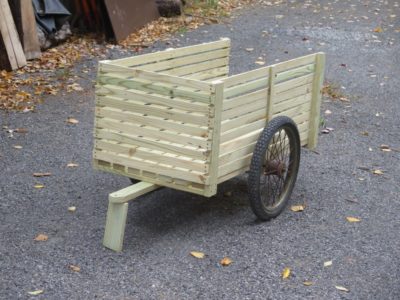
I ripped a pile of PT-SYP and assembled the unit with deck screws. I will make and affix the tail gate at some point soon, depending on weather and other projects. I’ll also fit it with a tarp liner so dirt and gravel can be hauled without falling through the cracks.
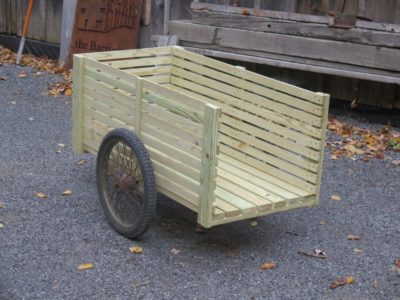
It was satisfying to get such a nice project in just a few hours of low-intensity work, requiring little precision and only a framing square and screw gun for assembly.
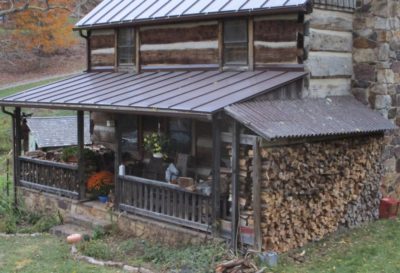
It’s time for the ceremonial portraits of this winter’s firewood. Even with the side crib already almost half-full after last winter, it took four days for me to load the pickup and move wood from the stacks of seasoned wood into the crib and on to the front porch. I’m working as hard as I always have but the output is diminished.
After the performance of the cabin envelope last winter following the complete re-chinking the previous year (that alone cost twice as much as my first house) and the crawl space sealing and insulating the year before, I am fully confident that even with a severe winter we are all set. In previous winters it took almost two full side cribs plus the porch-full to keep Mrs. Barn warm enough, this past winter it took the porch-full plus half a crib-full. I’m liking that trend line.

We’ve got new high performance windows on order to replace the 80s era windows now in place, windows with the particular feature of providing wonderful ventilation year round, open or closed. Depending on the performance of the supply chain we will be getting the new windows installed just before the dead of winter. Keeping fingers crossed. With new windows, the cabin should be cozier than ever.
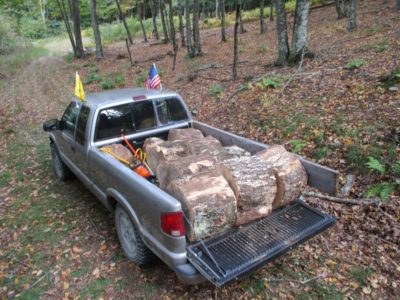
Tomorrow I start splitting, stacking, and seasoning the firewood for the coming winters. There’s still at least two or three dozen heaping trucks full of timber on the ground. If I get done with everything already on the ground, I calculate 4-6 winters of firewood a-waitin’.
… to harvest firewood for the coming winters.
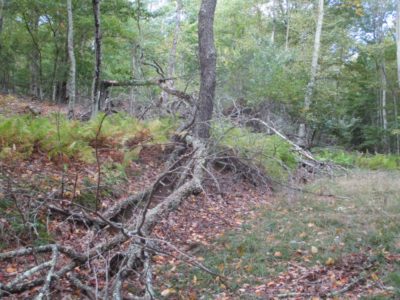
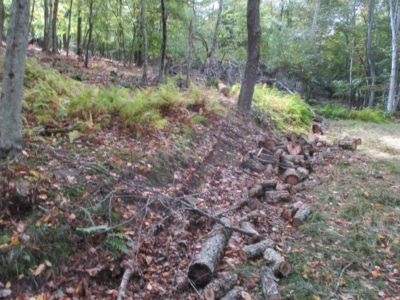

The pile as of two days ago.
This coming winter is already taken care of, so now I am working on winters 2023, 2024, 2025, etc. This week I have done nothing but retrieve a small portion of the windfall over the past year, yielding a heaping pickup every day. Thus far my mountain of firewood to be split and stacked is about 1-1/2 winters, maybe more if the new cabin windows make the same difference as did the two previous projects — insulating and sealing the crawl space under the cabin, and replacing all the chinking between the logs. These two ventures resulted in cutting our firwood needs by almost 50% last winter.

The road up to the previously felled timber is blocked by windfall trees which must be cut up and removed to even get to the upper inventory. Each of these trees renders almost a full pickup load of cut bolts.

I haven’t even made it to this tree yet, with its 40+-feet of clear trunk almost 24″ in diameter. If it were less logistically challenging, I would contemplate getting this one milled into slabs.
I’ve retrieved four truckloads, with at least another dozen still awaiting my ministrations.

This maple log was a particular challenge as I had to use some block-and-tackle to enable my little pickup to drag it uphill and on to the road so I could work it. This made me appreciate my little Stihl saw all the more. It is small and lightweight but can handle an 18-inch bar due to its narrow chain. I keep the chain sharpened several times a day and have to swap out the current chain because I’ve worn it to the nub.
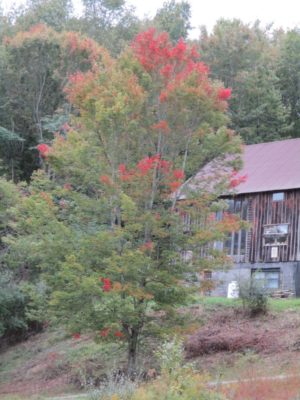
This week also brought the first swatches of color to the local flora.
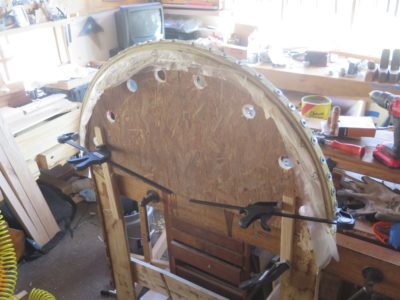

With the form for the curved ribs in hand I set about to making the four necessary ribs from 3/16″ strips of pressure treated lumber. Using the combination of T3 adhesive and my fender washer/deck screw method I clamped the laminations to the form, followed by a boat load of crown staples.
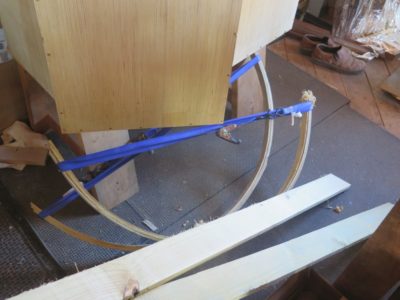
When the glue had set (but not hardened fully) I removed the ribs from the form and strapped them to maintain the proper dimension until everything was dry and hard. Unfortunately I do not have any pictures of the skeleton all assembled (I should follow the example of RalphB who is scrupulous about photographing his projects).



With the skeleton finished I stapled 1/2″ hardware cloth as a skin. This was a bit of a problem until I had a blinding flash of the obvious. The tip of the pneumatic stapler kept sliding off the wire of the hardware cloth, that is until I filed a tiny notch in the center of the stapler tip, the part that slides up as a safety measure. After that the process went amazingly fast.
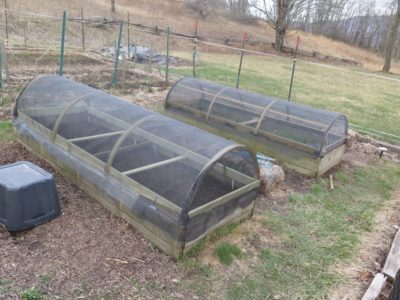

The hoop covers were really light and easy to maneuver into the proper place. Mrs. Barn wanted them to be attached and hinged so I made that happen, then covered them with a second skin of window screen to keep out the moths that love to eat up the veggies she grows inside.
Come winter we will cover these with plastic to turn them into mini-greenhouses so that she can grow things inside year-round. This works well enough, but a big improvement in this regard is coming soon to the homestead.
Stay tuned.
It’s that time of year when there’s a run-up to firewood season. I will soon find myself building a mountain of cut firwood next to the splitter and spending several days splitting and stacking the finished product to season and await its use. We do not need any firewood for the coming winter, and perhaps even into the start of next winter, but my goal is to get ahead of the heating fuel curve by three winters.
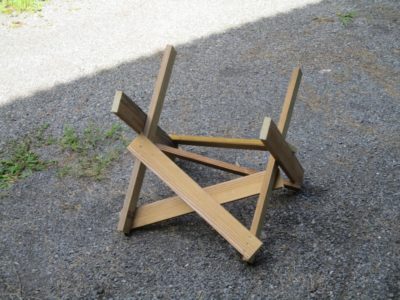
In addition to that we’ve had some work done on the homestead (more on that later) that is prompting some aggressive brush cleanup around the log barn near where my pal Bob felled some trees eighteen months ago. To that end I’ve spent the past two weeks working in the area extracting brush, cutting wood, and bush hogging.
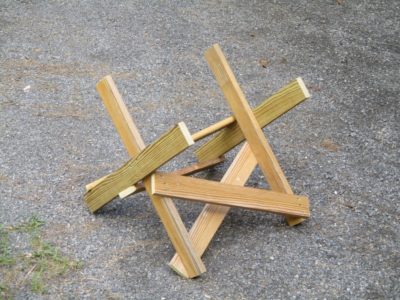
A simple tool I made from, once again, wood from the scrap inventory and decking screws, has been exceedingly helpful; a saw buck. It was made from pressure treated pieces left over from some long-forgotten project, took very little time or energy to become manifest. In sort, a perfect “mundanity.”
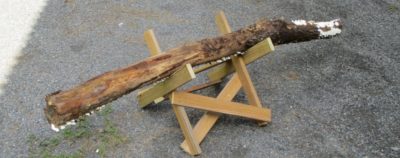
Exploiting the properties of triangles and diagonal bracing the saw buck is very light — I can move and maneuver it easily with one hand while the other is holding the idling chain saw — and also exceeding strong with a holding capacity of several hundred pounds. Thus I can easily get the piece(s) to be sawn up off the ground so that I don’t have to finesse the saw bar to keep it from touching the ground. Around here if the running chain hits the ground, it hits a rock, and off to sharpening it goes.
Our little corner of paradise has many idyllic features fitting my “Want List,” compiled over 30 years, almost perfectly. Remote? Check (as the realtors have advertised, we are three mountains back from the nuclear blast zones). Sparse population? Check (reputedly the lowest population of any county east of the Mississippi River). Isolation? Check (nearest permanent neighbors a mile away). Geographic beauty? Oh yeah.
Rich, loamy soil perfect for gardening? Uh, not so much. I actually think that the primary “agricultural” product of our region is not cattle and sheep but rocks. Even now after a dozen years of gardening the same spot Mrs. Barn gathers a new pile of rocks every Spring during her pre-planting preparations. By the way, this has to be done by hand as the “soil” will beat the ever lovin’ snot out of a garden tiller. I once rented a trencher to bury some electrical conduit. Didn’t last five minutes.

Recognizing the nature of the “soil” here I built a series of raised beds for gardening before we moved here. I ordered a truck load of “topsoil” that had to be screened to remove all the gravel, then filled the boxes with that screened dirt. Soon enough there were green shoots popping up.

Early on I affixed PVC hoops ribs on the boxes so they could be netted in the summer and covered with plastic in the winter. On two of the boxes I built removable screened hoop covers for the beds, and this past winter I was informed that the two screened covers were plumb wore out and needed to be replaced.

Given the importance of the enclosed raised beds I decided to make some first-class hoop covers for them. I began by taking the time to make a form on which I could assemble laminated curved ribs. Then the work got serious.
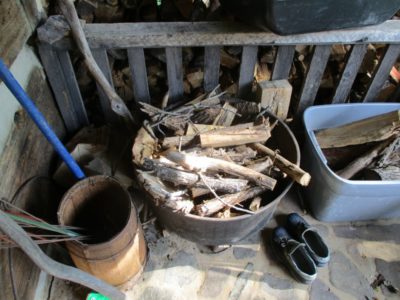
One of the things about living on the edge of the forest, especially if you are trying to carve out more space along the edge, is that you have to deal with a lot of wood and brush. Bigger trees are not a strategic problem, they get cut, split, and stacked as firewood. For branches smaller than wrist-sized it is a judgment call, are they firewood or are they kindling? For the most part in recent years the primary use was as kindling as Mrs. Barn, normally the fire tender as she gets up earlier than I do, would fill the giant cauldron on the front porch with sticks to serve that function throughout the winter.
The simplest way to deal with excess brush and branches is to just throw them back further into the frontier at the edge of the forest, a “solution” that bites you when eventually pushing that frontier back as we are doing right now. For the most part the ultimate solution is to either get a chipper or burn up the inventory in a burn pit or barrel.
Recently Mrs. Barn came up with brilliant idea — turn the excess into charcoal. This plan may or may not have coincided with her exploration of the Weber grill as a smoker/outdoor oven/broiler to keep heat out of the kitchen when it gets hot here (in the 80s). She has been experimenting with great success in that realm. Combined with my own interest in charcoal-making it seemed like this was the time to begin skipping down that path.
I hired a local fellow to do a ton of weed eating around the homestead, and one of the things that venture revealed was the number and size of brush piles we had underneath the greenery. So, I’ve been slowly pulling out the brush and clearing the path to the felled firwood trees out behind the log barn. Since it was going to be burned up anyway, why not try to turn some of it into charcoal?
I’d attended a charcoal-making workshop many years ago and remembered that the “controlled ignition” system while more efficient was also much trickier; you gotta get the burn conditions just right to cause the raw material to smolder until it was fully carbonized and no farther. The “retort” system — essentially cooking the wood down to its basic carbon form — though less efficient, struck me as much simpler and easier. So, I dug out a heavyweight small trash can, took it to the burn barrel, and gave it a try. With great success!
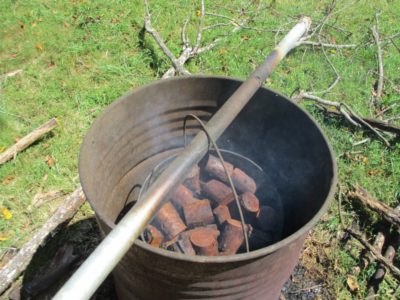
Actually the first step was to select a few wrist-sized branches and haul them up to the barn and cut them into 3″ pieces on the chop saw. When the small trash can was full it was time to head down to the burn barrel and give it a try.
I built about a six-inch bed of twigs at the bottom of the burn barrel and lit that, letting it burn and adding fuel until I had a hot fire. Then I lifted the small trash can into the barrel and sat it on the bottom fire. This was not particularly easy as the contents of the trash can had not been seasoned in any meaningful way, they had just been a pile of brush in the tall grass. The can was really heavy.

One I had the trash can situated in the barrel I fed a large galvanized pipe through the handle so that the trash can would hang once the bottom fire burned down. I did not know if this was a useful approach but it seemed like a smart way to even out the heat through the charcoal can. I then selected a large number of smaller branches, 1″ – 2″, and hand cut them into 6-inch pieces which I then fed into the barrel all around the outside of the charcoal can, filling up the barrel to the lid of the charcoal can. I laid a handful of 2-inch sticks on top of the trash can and waited to see what happened.
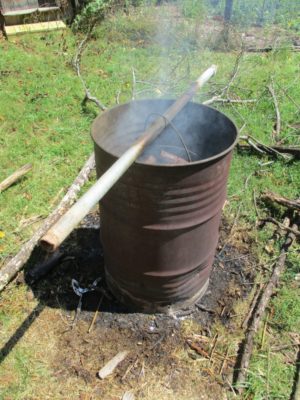
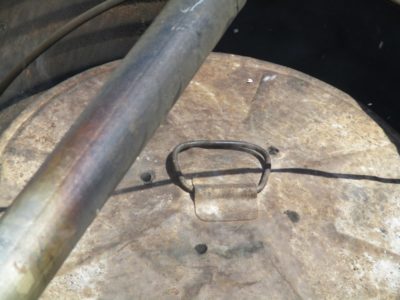
As expected, soon enough there was a plume of steam coming out of the four holes I had pre-drilled into the lid of the trash can, as first the unbound water and then the bound water was distilled out of the wood. This process took about three or four hours. All I had to do was stand there and watch.
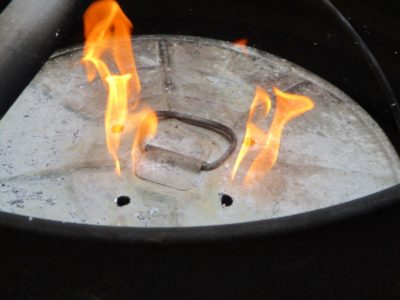
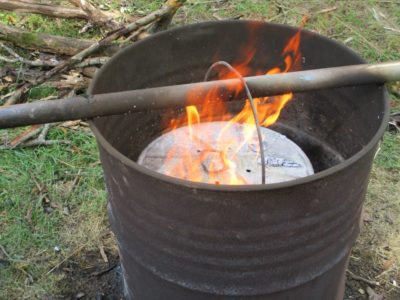
The real excitement occurred at about the 4-5 hour mark as the moisture was all gone — the presence of the moisture had regulated the internal temperature to 212 degrees (remember 9th grade Physical Science?) — and the temperature inside the trash can jumped to the point where formaldehyde and methanol were being distilled off from the carbonizing wood. Quick as a flash I had jets of flame whooshing out of the holes in the lid and from around the rim where the lid fit the trash can. For almost an hour the flames did their job, then they were gone.
After that I let the entire barrel-and-trash-can stay undisturbed while any remaining fuel burned off and the whole thing cooled down over night.
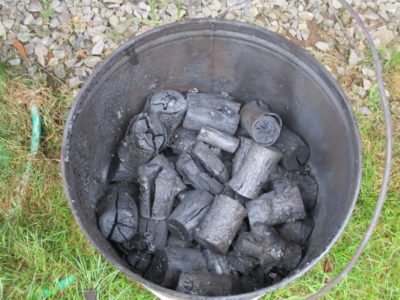
In the morning I could hardly wait to see what I had wrought. The results were spectacularly successful, beautiful charcoal just waiting to be put to use on the grill. The end product was 1/3 smaller and 3/4 lighter than the original. I’ve got the system down pat and will make more charcoal as the spirit leads. I’m going to burn up all the wood anyway.
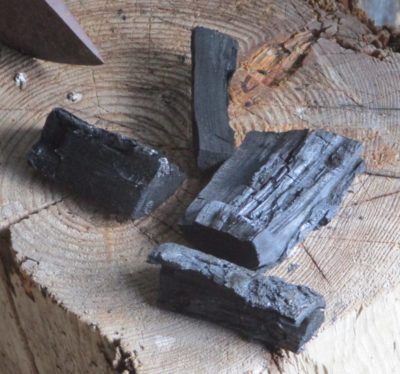
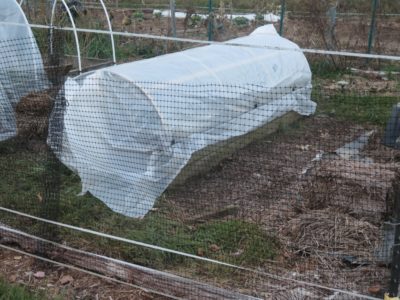
Another of the regular winter/spring/summer rituals here in Shangri-la is to re-think the carpentry needs for the gardens, and this year two new hoops over the raised beds percolated to the top of the pile. There had been hoops before but those were made in haste and only lasted ten years. The time had come for something a bit more robust. They get used year round, in the winter to serve as mini-greenhouses, in the summer to keep out the cabbage butterflies.


I decided to make the ribs with three lamina instead of two, so I ripped the requisite number of 1/4″ strips from pressure-treated 2x lumber. The actual forming/laminating process began with constructing a form that can serve to fabricate laminated hoop ribs from now until I become part of the landscape myself. I used scrap materials for the form and used clamps for making the first curved ribs. I used up all the clamps I had that would fit and kept them engaged for 24-hours (I used T3 adhesive).

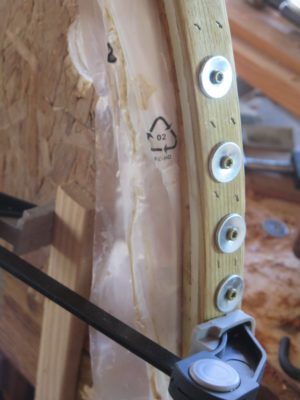
I got smarter. On subsequent ribs I used deck screws and fender washers to clamp the laminations to the form. With the addition of crown staples I was able to assemble two ribs per day.
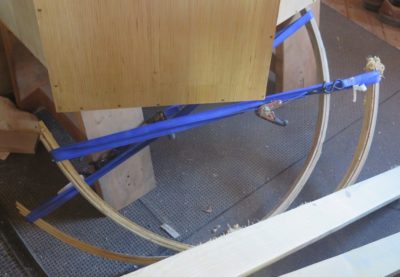
After removing the laminated ribs from the form I restrained them with ratchet straps to keep the correct shape and size, and set them aside. Once I had enough I could assemble the skeleton and cover it with the screening.
Stay tuned.
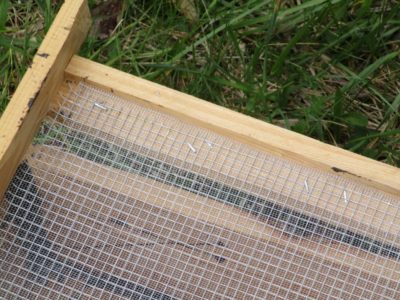
The end was definitely in sight. All I needed to do was make the fitted lid with two layers of screen, window screen supported by 1/4″ hardware cloth and haul it the 350 yards to the weir dam. Somehow I have misplaced the camera with most of the lid-making images.
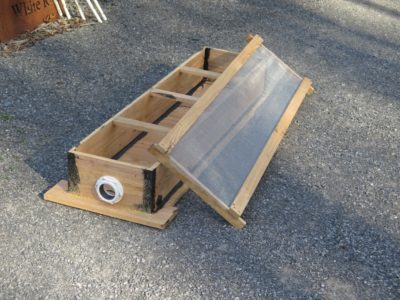
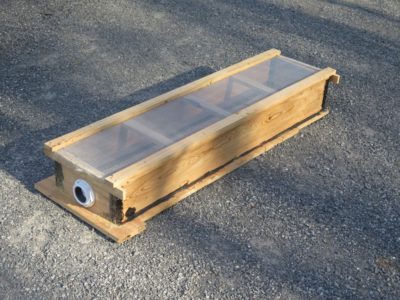
It was very satisfying to see the unit all together, ready to get to work. The only hard part of the project, really, was hauling it up the hill. It is very awkward and though not especially heavy, it was not a feather weight either. I actually strained a tendon in my left hand rasslin’ it up the hill but that is recuperating nicely.

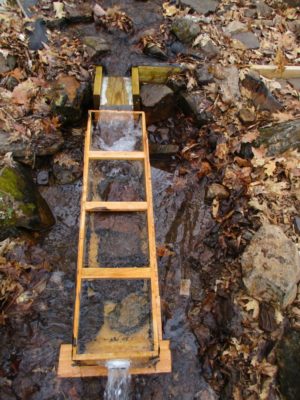
Once I got it up to the top I had to spend some time re-configuring the creek bed since the new box is so different from the old Rubbermaid tub. But when it went in place with a solid WHUMP! as it filled with almost 100 pounds of water I knew the this was just right. To make sure it would stay put from either a rushing thunderstorm torrent or a rummaging bear I filled it with several hundred pounds of rocks.
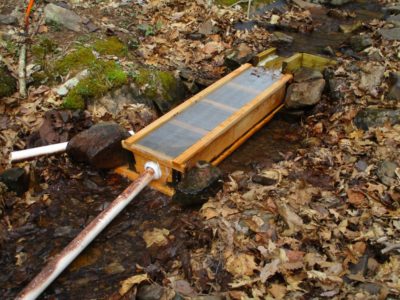
The connection to the pipeline was a slip-fit gasket inside the shower drain fixture so I hooked it up and we were off to the races.
*Now all I have to do is make a new metal chute and it’s done.
With the dovetailed box sides assembled I moved on to attaching the board bottom. The orientation of the wood there was such that it will cause the maximum swelling and thus compression sealing that panel.

My strategery was to lay down a bead of asphalt and screw thing down tight for each board. I left each board over-length by about an inch to reduce the risk of splitting from the screws. I left the end board even longer to allow for a more stable outrigger effect when sitting in the stream after installation.
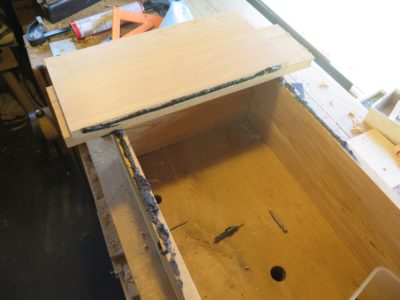
The successive board was tarred to both the sides and the preceding board. Tidiness was not the objective, sturdy durability and performance was. My only real objective was squeeze-out.
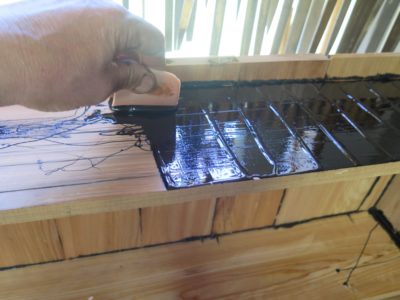
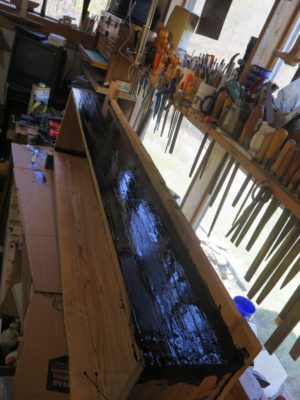
When the bottom was in place I turned my attention to one of the side boards that had a bit of surface cracking. I trowelled on some tar on that whole surface just to make sure it would remain intact. Probably overkill.


A line of tar on the inside and outside of each corner completed the assembly. Using a hole drill I installed the shower drain fixture that served as the connector for the penstock water line.
Now all I had to do was make the screen lid and haul the monster up the hill.























































Recent Comments